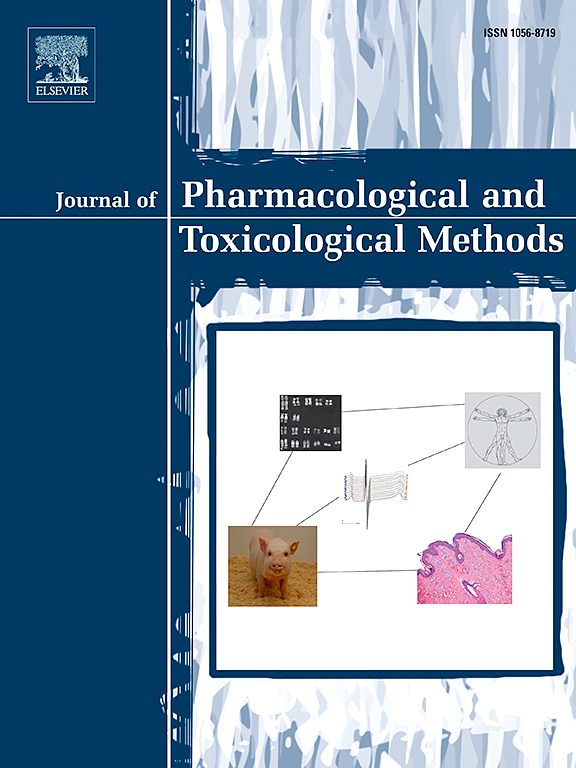Building a robust CNS screening strategy: Integrating in vivo and in vitro assays to better predict CNS risk
IF 1.3
4区 医学
Q4 PHARMACOLOGY & PHARMACY
Journal of pharmacological and toxicological methods
Pub Date : 2025-05-01
DOI:10.1016/j.vascn.2025.107662
引用次数: 0
Abstract
Attrition within clinical development due to central nervous system (CNS)-related adverse events continues to highlight the need to refine CNS screening strategies. The primary preclinical method to assess CNS risk is the Irwin/Functional Observation Battery (FOB). However, these tests are significantly limited by subjective assessment and temporal resolution. Automated neurobehavioral assessment, such as the Home Cage Analyzer (HCA), can overcome these issues. In addition, in vitro methods, such as microelectrode array (MEA), provide greater throughput and improved translation when using human iPSCs. Ideally, the combination of neurobehavioral and electrophysiological endpoints would converge to provide a clearer picture of CNS perturbance. Critically, a robust CNS screening strategy hinges upon understanding the limitations of such methods and identifying potential gaps in sensitivity between them. This study aimed to validate the Home Cage Analyzer (HCA) and test for convergence or difference in sensitivity between in vivo and in vitro screening using potent CNS active compounds from two distinct drug classes: psychostimulants and sedatives. For HCA experiments, eight male Wistar Han rats (Charles River) were implanted with temperature sensitive RFID transponders (Biomark USA) and pair housed in individually ventilated cages (Tecniplast). Rats were maintained under a 12-h light/dark cycle and habituated to the testing room and HCA rack for 1 week prior to initiation of dosing. Using a crossover Latin-square design, each rat received a single dose of d-amphetamine (0.25, 1, or 3 mg/kg), diazepam (0.5, 1.5, 5 mg/kg), or saline/vehicle. For MEA experiments, hiPSC-derived cortical neuron/astrocyte network (Fujifilm CDI) or rat cortex (E18.5; QBM Biosciences) was cultured in a Maestro Multi-electrode Array System (Axion BioSystems; 48-well plate). l-amphetamine in saline (0.12, 0.37, 1.11, 3.33, 10, 30 μM) or diazepam in DMSO (0.1, 0.3, 1, 3, 10 μM). As expected, we found a dose-dependent increase in activity after treatment with amphetamine in the HCA. Conversely, rats treated with diazepam showed decreased activity levels within the HCA. In line with neurobehavioral effects, diazepam caused a significant decrease in spiking and burst frequency in the MEA, resulting in a well-defined sedative phenotype. Surprisingly, amphetamine application in iPSCs exhibited no phenotypic response within the MEA, including no change in burst rate. Importantly, this lack of an effect in the MEA could be interpreted as a “clean” result, thus representing a missed hazard. In contrast, diazepam demonstrated consistent effects in the HCA and MEA. Together, these results indicate complementarity between in vitro MEA assay and in vivo automated HCA when screening sedatives while revealing a gap between these assays for amphetamine. Thus, a multi-modal approach is critical to a robust CNS screening strategy.
建立健全的中枢神经系统筛查策略:整合体内和体外检测以更好地预测中枢神经系统风险
由于中枢神经系统(CNS)相关不良事件在临床开发中的损耗继续突出了改进中枢神经系统筛查策略的必要性。评估中枢神经系统风险的主要临床前方法是Irwin/功能观察电池(FOB)。然而,这些测试明显受到主观评估和时间分辨率的限制。自动神经行为评估,如家庭笼分析仪(HCA),可以克服这些问题。此外,体外方法,如微电极阵列(MEA),在使用人类iPSCs时提供了更高的通量和改进的翻译。理想情况下,神经行为和电生理端点的结合将汇聚在一起,以提供更清晰的中枢神经系统扰动图像。至关重要的是,一个强大的中枢神经系统筛查策略取决于了解这些方法的局限性,并确定它们之间潜在的灵敏度差距。本研究旨在验证家用笼式分析仪(HCA),并测试两种不同药物类别(精神兴奋剂和镇静剂)中有效的中枢神经系统活性化合物在体内和体外筛选之间的敏感性趋同或差异。在HCA实验中,8只雄性Wistar Han大鼠(Charles River)植入了温度敏感的RFID应答器(Biomark USA),并将其饲养在单独通风的笼子(Tecniplast)中。在开始给药前,将大鼠维持在12小时的明暗循环下,并在试验室和HCA架上习惯1 周。采用交叉拉丁方设计,每只大鼠接受单剂量d-安非他明(0.25、1或3 mg/kg)、地西泮(0.5、1.5、5 mg/kg)或生理盐水/药。MEA实验采用hipsc衍生的皮层神经元/星形胶质细胞网络(Fujifilm CDI)或大鼠皮层(E18.5;QBM Biosciences)在Maestro多电极阵列系统(Axion BioSystems;48-well板)。l-安非他命溶液(0.12,0.37,1.11,3.33,10,30 μM)或地西泮溶液(0.1,0.3,1,3,10 μM)。正如预期的那样,我们在HCA中发现安非他明治疗后活性呈剂量依赖性增加。相反,用地西泮治疗的大鼠显示HCA内的活动水平下降。与神经行为效应一致,地西泮导致MEA的尖峰和爆发频率显著降低,导致明确的镇静表型。令人惊讶的是,安非他明在iPSCs中的应用在MEA内没有表现出表型反应,包括爆发率没有变化。重要的是,多边环境协定中这种影响的缺乏可以被解释为“干净”的结果,从而表示错过了危险。相反,地西泮在HCA和MEA中表现出一致的效果。总之,这些结果表明,在筛选镇静剂时,体外MEA测定和体内自动HCA之间具有互补性,同时揭示了这些测定在安非他明方面的差距。因此,多模式方法对于稳健的中枢神经系统筛查策略至关重要。
本文章由计算机程序翻译,如有差异,请以英文原文为准。
求助全文
约1分钟内获得全文
求助全文
来源期刊

Journal of pharmacological and toxicological methods
PHARMACOLOGY & PHARMACY-TOXICOLOGY
CiteScore
3.60
自引率
10.50%
发文量
56
审稿时长
26 days
期刊介绍:
Journal of Pharmacological and Toxicological Methods publishes original articles on current methods of investigation used in pharmacology and toxicology. Pharmacology and toxicology are defined in the broadest sense, referring to actions of drugs and chemicals on all living systems. With its international editorial board and noted contributors, Journal of Pharmacological and Toxicological Methods is the leading journal devoted exclusively to experimental procedures used by pharmacologists and toxicologists.
 求助内容:
求助内容: 应助结果提醒方式:
应助结果提醒方式:


